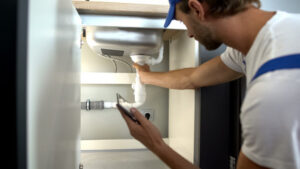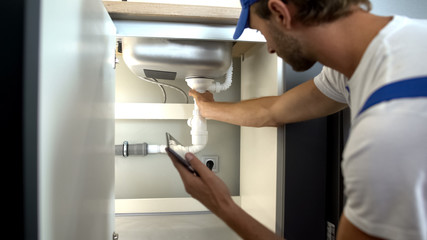As the term implies, Plumbing is the study of the conveyance of fluids. It uses pipes, valves, plumbing fixtures, tanks, and other apparatuses to move and convey fluids. These appliances are essential for several applications. Plumbing is also called pipework. There are several careers in the field. In addition to residential and commercial buildings, the field also reaches far beyond these areas. However, it is often associated with home and business plumbing.
 Many types of plumbing can be employed for residential and commercial purposes. Plumbing technicians can install and maintain these fixtures, from sinks to bathtubs. In addition, plumbing can include sanitary and storm drainage systems, water-softening equipment, and venting systems. Plumbing professionals can also work with public water supply systems. Ultimately, plumbing is an essential part of home maintenance, and it can help you keep your home in top condition.
Many types of plumbing can be employed for residential and commercial purposes. Plumbing technicians can install and maintain these fixtures, from sinks to bathtubs. In addition, plumbing can include sanitary and storm drainage systems, water-softening equipment, and venting systems. Plumbing professionals can also work with public water supply systems. Ultimately, plumbing is an essential part of home maintenance, and it can help you keep your home in top condition.
The importance of plumbing is indisputable. The profession ensures safe and hygienic use of water. Plumbing has always been a part of every construction plan, right from ancient times. Today, the industry has come a long way, and has even registered professional associations to regulate itself. Plumbing is a vital component of home and business construction and ensures that water and waste are used safely. Even in developing countries, the plumbing industry has saved many lives through its contributions to the quality of life and safety.
A toilet is the most important plumbing fixture in a home. The flush system inside it helps move waste away. However, this fixture is used continuously and eventually needs repair. Regular inspection of the base of the toilet can help you prevent toilet problems in the future. Most plumbing fixtures contain a drain protected by a trap or strainer. These devices keep harmful gasses out of the house. This way, a homeowner can prevent a clogged drain in the future.
PEX pipes are made from flexible, low-cost plastic tubing. These pipes are easy to install and need fewer fittings than rigid plumbing systems. PEX pipes are color-coded and come in different sizes, making them easier to join and cut. PEX pipes are commonly colored for hot and cold water and are durable. This makes PEX pipes a good choice for corrosive water environments and new homes. So you’ll be able to see the pipes you need in no time.
A plumbing engineer will draw a plumbing layout plan. A plumbing plan will include connection diagrams. The typical plumbing diagram will include a sanitary stack and water supply system. Afterwards, legends will be added. Small projects typically require only one sheet of plumbing layout plans. For large projects, separate sheets of plumbing layout plans are needed. One example of a plumbing layout plan in Figure 6.20. In this diagram, you’ll see how all of the plumbing fixtures and pipes are connected.
You’ll find many resources on the Internet to learn more about plumbing. Online courses, books, and videos guide you through the plumbing process. Plumbing is the system that brings fresh water into your home and transports wastewater out. It is important to understand how your plumbing system works to avoid costly repairs and breakdowns. Once you understand the basics of plumbing, you’ll be able to use this knowledge to make informed decisions about plumbing in your home.
Plastics are another option for pipes and tubing. These are often corrosion resistant and can be shaped into whatever shape you desire. They also tend to last for many years. A good plastic pipe will usually cost less than a metal one, making them a great choice for plumbing. So, which kind of piping should you use? You should choose based on its function and the layout of your space. Choosing the right piping depends on many factors, including cost. Copper is cheaper than plastic or steel, but you should also remember that the former is more durable.
Water supply systems deliver clean water from the street to the house, and then to various fixtures and appliances. Waste water is carried to a sewer system, and natural gas plumbing transports natural gas fuel to appliances and other places. Commercial projects use plumbing to transport liquids and gases. It is essential to maintain a functioning plumbing system. But, despite the complexity of plumbing systems, most homeowners are completely unaware of the complexities involved. Just like the name suggests, we turn a faucet or press a button, expect water to come out at the temperature and pressure that we want.
